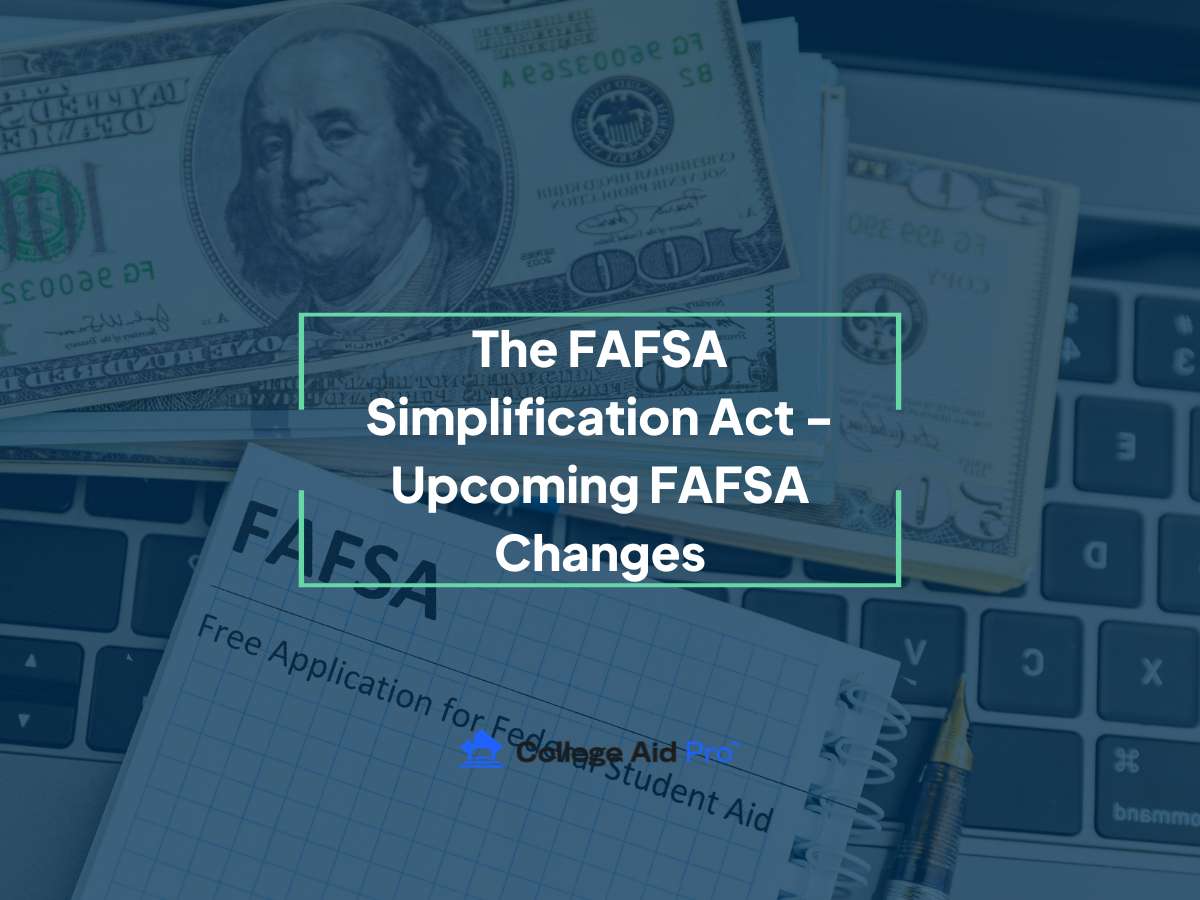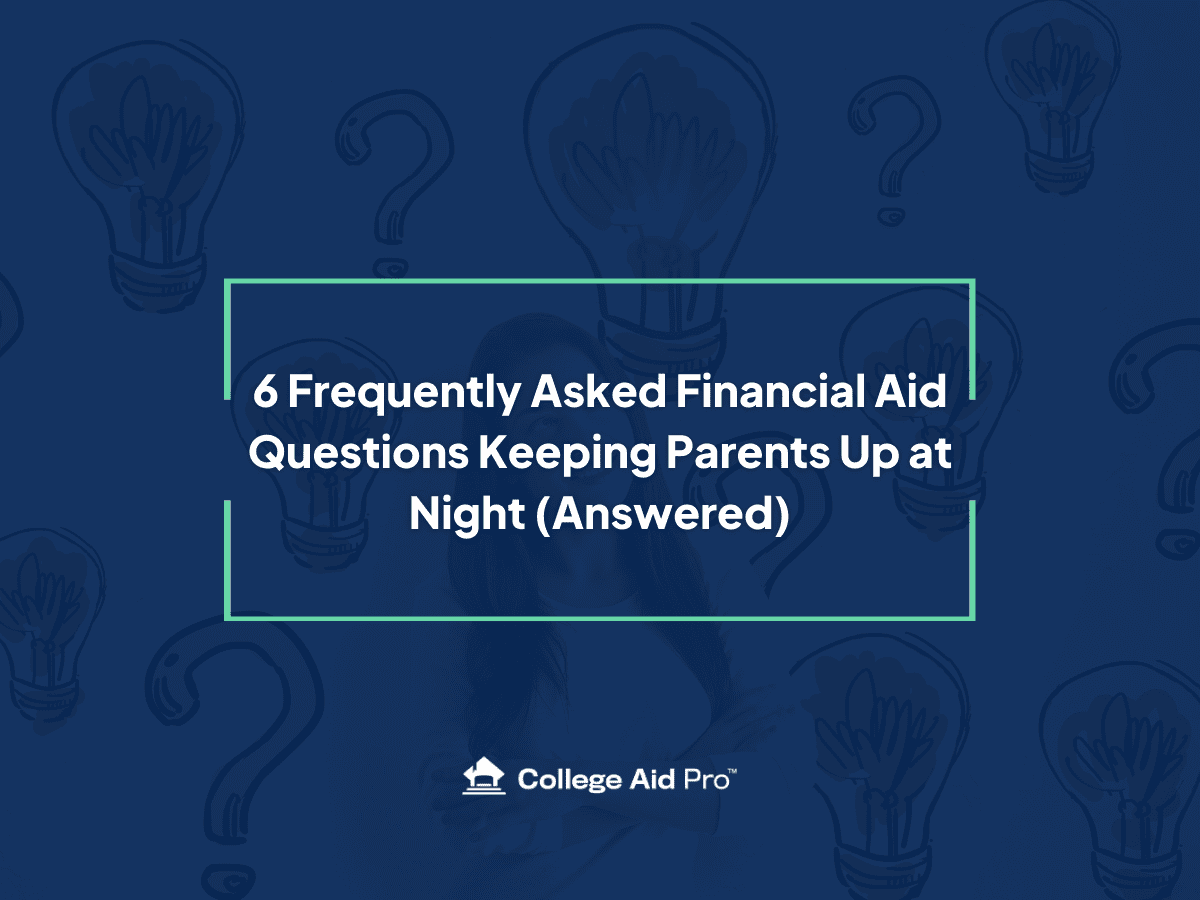With the FAFSA Simplification Act comes a host of changes to the way federal student aid is calculated. Some of those changes have already been implemented, but the bulk of them are slated to come into play with the FAFSA application period applicable for the 2024-2025 award year.
There is still some confusion out there about how these changes will affect aid, so here is what we know. Mind you, not all of these changes are good for families.
CLICK HERE to sign our petition to stop some of the more controversial changes like not lowering the EFC (soon to be SAI) for families with multiple kids in college simultaneously and requiring small business values to be included in the formula.
Changes Planned For the 24-25 Award Year
EFC Becomes SAI
What we all know as the EFC or Expected Family Contribution will be renamed as the SAI or Student Aid Index. This may possibly help alleviate some of the confusion that comes into play when families find out that they may have to pay more than the EFC for many schools.
Lear more about the Expected Family Contribution: Understanding the Expected Family Contribution in FAFSA
The FAFSA Gets Shorter
One good change is that you won’t have to answer as many questions when filling out the new FAFSA. The list of questions is going from about 108 to about 32 – that’s a big drop!
Having Multiple Children In College Won’t Help
Up until now, the EFC calculation has been divided by the number of children in college simultaneously. The SAI does away with that perk. The provisions do specify this as a special circumstance that can be brought to the attention of the school under the Professional Judgment expansion, discussed below.
- Planning Opportunity – If you will have multiple family members in higher education during the same year, consider seeking Professional Judgment or appeal for more financial aid. See “Some Changes That Have Already Been Enacted” for more information on Professional Judgment.
College Aid Pro feelings strongly that this change by the Department of Education should be removed. Eliminating this discount will make it that much harder for family’s to pay for college and potentially add to the student debt crisis we already face. Join us in our effort to get this part of the FAFSA Simplification Act repealed: Sign Our Petition
Small Business and Farm Values Get Added To The Formula
Instead of being excluded from the FAFSA formula, small business and farm owners will now be required to share the value of their business or farm on the FAFSA. This value will be included in the SAI calculation.
The new valuation will work as follows:
- For a net worth of up to $135,000, the adjusted net worth would be net worth x 40%.
- For a net worth between $135,001 and $410,000, add $54,000 plus 50% of the amount over $135,000.
- For a net worth between $410,001 and $680,000, add $191,000 plus 60% of the amount over $410,000.
- For a net worth over $680,000, add $353,500 plus 100% of the amount over $680,000.
Your SAI Can Be Below Zero
Currently, the FAFSA formula does not permit for an EFC of less than 0. With the changes, a family’s SAI can be as low as -$1,500. This will allow for some very needy students to receive aid in addition to the cost of attendance.
The Pell Grant Gets An Expansion
The new Pell Grant formula is linked to family size and the federal poverty level and breaks down like this:
- Maximum Pell Grant – awarded to students with an SAI of 0 or lower. For the 2022-2023 school year the dollar value is $6,895.
- SAI based calculation – For students with an SAI of 1 or higher but less than the maximum Pell Grant award amount, the Pell Grant award is calculated as
- Max Pell Grant – SAI = Pell Grant Eligibility
- This amount is adjusted down for part time students
- The Pell Grant cannot exceed the cost of attendance
- Additional Path To Pell Grant Eligibility – For some students with an SAI that exceeds the Maximum Pell Grant award. This calculation takes into account AGI, family size and the federal poverty guidelines.
Students Exempt From Reporting Assets (Formerly The Simplified Needs Test) Gets A Boost
The SAI provides an AGI threshold indicating to families whether or not they will be required to report assets (savings balances, investments, etc.) on the FAFSA. Under this new formula, families with an AGI of up to $60,000 will not be required to report assets on the FAFSA, which is a $10,000 increase from the current Simplified Needs Test threshold.
- Planning Opportunity – If you have assets and your AGI is hovering near $60,000, try to keep it from tipping over that amount in order to avoid having to report assets on the FAFSA. One way to lower your AGI if it is just over the threshold would be to contribute to a pre-tax retirement plan at work.
Some Income Add-Backs Go Away
Currently, if you contribute to a pre-tax retirement plan, the federal formula will add those contributions to your AGI when calculating your EFC. Starting with the 2024-2025 school year, the pre-tax contributions you make through your paycheck will not be added back to your AGI.
- Planning Opportunity – Saving pre-tax through your employer into a 401k or 403b will now be a viable way to reduce income and achieve a lower SAI.
Child support received will no longer be added to your income. However, the amount of the payments will be added to your non-retirement asset total. This is good as assets do not count as heavily toward the SAI calculation as income does.
Students have been hit hard in the past when they received financial help from family members or friends as that was considered untaxed income to the student. Going forward, that will no longer be the case.
- Planning Opportunity – Funds used from a grandparent-owned 529 will not be considered untaxed income to the student so this is a viable college funding strategy that does not require special timing when using the funds.
Learn more about two household families: What Divorced, Separated and Two Household Families Need To Know About the FAFSA and CSS Profile
The Income Protection Allowance Gets Bigger
The IPA or Income Protection Allowance shields part of an applicant’s income from being assessed for the SAI. The good news is that the allowance is going up by about 20% for parents and by about 35% for dependent students, and it will be adjusted for inflation. The bad news is that the number of family members in college at the same time will no longer be a factor.
Another related change is that the allowance for state taxes is going away, which will represent an increase in income for the SAI of between 1% and 9%.
The Employment Expense Allowance Gets Tweaked
The FAFSA methodology allows for a small amount of up to $4,000 to be deducted from income to account for miscellaneous expenses related to employment. To qualify for this allowance, you must be one of the following:
- The parent of a dependent student
- An independent student with dependents
- An independent student who is married
This allowance was previously only available to married couples if both had earnings. Now it is calculated based on total income so that married couples with only one working spouse can qualify. Unfortunately, single independent students without dependents still don’t qualify.
Students Who Can’t Provide Parents’ Information Get Another Option
There are a certain number of students who, for whatever reason, can’t provide their parents’ financial information, but also don’t qualify for an exception from doing so. Instead of being unable to submit a complete FAFSA, these students will now be able to file as Provisional Independent Students and submit a complete FAFSA form.
Once received, the financial aid administrator will then notify the student of the process by which they must confirm their dependency status. Once the administrator receives requested information, they will use the Professional Judgment process to make a determination about the student’s financial aid.
Reporting For Two Household Families Changes
Instead of reporting financial information on the parent (and spouse, if applicable) with whom the student lived most of the year, the new formula requires information on the parent (and spouse, if applicable) who provided the majority of the student’s financial support regardless of who the student lived with.
Learn more about two household families: What Divorced, Separated and Two Household Families Need To Know About the FAFSA and CSS Profile
Some Changes That Have Already Been Enacted
Incarcerated students are eligible for Pell Grant starting with the 2023-2024 award year.
Lifetime Pell Grant eligibility applies to students if:
- Their school closed while they were enrolled
- Or, the school misled the student in some way
Schools are now being required to report the cost of attendance to students using a more encompassing method that includes loan fees and miscellaneous direct and indirect costs for completing their program.
Professional judgment, which allows financial aid officers to adjust components of the need equation for students in special circumstances, is being expanded. Institutions are also now required to disclose openly that such adjustments may be available.
- Special circumstances may include, among other things:
- Loss of income
- Housing change
- Homeless youth
- Orphans
- Foster youth
- Large medical expenses
- Multiple family members enrolled in higher education
- Adjustments can be made to
- Cost of attendance
- Dependency status
- Pell grant determination
Learn more about asking for professional judgment and appealing for more financial aid: How To Navigate Financial Aid Appeals With Your College-Bound Student
Keep in mind that some changes planned for next year will take a lot of time and manpower to enact, so there is still the possibility of further delays. Be assured that College Aid Pro will be watching and listening carefully to all the breaking news coming from the Department of Education.



